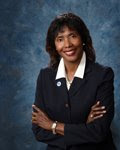.jpg) On September 11, 2009, C. Vivian Stringer, head coach of Rutgers University’s Scarlet Knights women’s basketball team, former head coach of Iowa State University’s Hawkeyes, former head coach of Cheyney State’s Wolves, and the self-proclaimed coal miner’s daughter, was inducted into the Naismith Memorial Basketball Hall of Fame. As usual, Coach C. Vivian Stringer’s presence on the Hall of Fame stage was the epitome of courage, grace, and class.
On September 11, 2009, C. Vivian Stringer, head coach of Rutgers University’s Scarlet Knights women’s basketball team, former head coach of Iowa State University’s Hawkeyes, former head coach of Cheyney State’s Wolves, and the self-proclaimed coal miner’s daughter, was inducted into the Naismith Memorial Basketball Hall of Fame. As usual, Coach C. Vivian Stringer’s presence on the Hall of Fame stage was the epitome of courage, grace, and class. While giving her acceptance speech, Coach Stringer stood under three university’s logos representing her journey in basketball and the teams she led to the Final Four—Cheyney University, Iowa State University, and Rutger’s University. In her speech, Coach Stringer focused on the value of family, her love of coaching, and the pivotal contributions of family and friends who helped her through numerous difficulties in life.
Coach Stringer gave special thanks to Coach John Chaney who served as her mentor and guide. Coach John Chaney was previously enshrined in the Naismith Memorial Hall of Fame in 2001. Both Coach Chaney and Coach Stringer helped to build recognition of the men’s and women’s basketball programs at Cheyney State College—from relative unknowns to national contenders.
Watching her recount those special moments in her life, and in the lives of others, reminded me that for Coach Stringer, basketball is the vehicle she uses to help develop future female leaders who are tough, resilient, and courageous.
The 2009 Hall of Fame Ceremony was truly a star-studded night which provided an opportunity for a glimpse into the excellence and greatness of some extraordinary Americans. Inducted with Coach Stringer were four others—former Utah Jazz team player and all-time assist leader, John Stockton; “the Admiral,” David Robinson, of the San Antonio Spurs; Jerry Sloan, the long-reigning coach of the Utah Jazz; and the legendary Michael Jordan of UNC, the Chicago Bulls, and the Washington Wizards.
After listening to the acceptance speeches and personal journeys of all of the inductees, it seems that the life journeys of the 2009 inductees demonstrate many qualities that are admirable in our society that extend far beyond basketball. John Stockton, at 6’1”—demonstrated excellence by hard work, physical and mental toughness, loyalty, and assisting others (especially Karl Malone) as a point guard with the Utah Jazz. Similarly, Jerry Sloan’s journey was characterized by loyalty to the Utah Jazz. He is one of the longest-serving and most successful coaches in the NBA. David Robinson also illustrated excellence with the San Antonio Spurs his entire career including mentoring former Wake Forest University star, Tim Duncan. He joined the NBA after serving as an officer in the US Navy. His off-court contributions are as admired as his basketball excellence. Robinson has contributed over $9 million to community efforts to help mentor and develop the skills of the next generation of youth. Michael Jordan’s phenomenal basketball journey and his acceptance speech at the Naismith Hall of Fame ceremony centered on the need for competitiveness to refine one’s skills to achieve excellence. Michael Jordan is credited with elevating the NBA’s influence globally, reaching the status of cultural icon, and contributing philanthropically to many causes. Michael Jordan, or Air Jordan, has been known to state that if you put in the work, results will come.
In fact, in addition to the glitz and red carpet of the September 11th Hall of Fame ceremony, the stories of the extraordinary athletes and coaches seemed to portray us at our best. Possibly, that is why we admire them so much. Undoubtedly, the athletic feats and the personal and mental toughness demonstrated by the 2009 Hall of Fame Inductees offer us a glimpse of many other untold stories of heroism, intensity of purpose, and excellence. The Inductees in the Basketball Hall of Fame show us the best of what we are, and what we can be, when we commit ourselves to a defining purpose. For Coach Stringer, coaching young women in basketball furnishes an opportunity for her to help guide others through life, and pass them “the baton” to assume the task of “paying it forward.”
Geri and I had the honor, and the privilege, of representing the Cheyney University family at the ceremonial events. Even though I am a long-time basketball fan, this was the first time we attended the Naismith Basketball Hall of Fame ceremonies. The entire Cheyney University community thanks C. Vivian Stringer for remembering us in her moment of well-earned victory. You always have a home here—Coach Stringer!



